Matador Network's Blog, page 2252
June 23, 2014
12 signs you married an Irishman

Photo: John O’Nolan
1. You’ve acquired a whole new language to play with.
Words such as “eejit” which, let’s face it, is way more fun to say than “idiot.” But you don’t have to stop there — you can also call someone a tool or a gobshite.
2. Your 3-year-old starts swearing early on.
But instead of the odd word of profanity, he comes out with a full phrase as he screams, “Oh for feck sake” as he climbs into the toy car in the playground. As the mom, if you’re living in Ireland you’ll be grand, and if you live in a non-English-speaking country you can hope no one noticed or understood. But if you live in another English-speaking country, you’ll probably just have to perfect the act of pretending this child isn’t yours.
3. Last calls at the pub no longer mean “one for the road.”
Instead, you now know it means everyone buys everyone else a pint just before the bell rings so you have a line of drinks waiting for you and no longer need the bartender. Often the bartender will just end up joining the rest of you anyway and then you’re in “lock in,” which means you’ll be let out in the morning.
4. Visiting family doesn’t mean just mom, dad, and siblings.
But tea and biscuits with every aunt and uncle, as well as all 50+ cousins, over a full week. If you’re like me, you’ll still be struggling to wrap your ears around the accent and keep up with the slang, and end up drifting off into a daydream while overeating on cookies and cakes.
5. You’ll never again serve someone tea without having biscuits or cake or some kind of food on offer.
Tea equals food — it will be expected! You need to keep a good stock cupboard full of tea goodies, especially with the amount of relatives around every corner.
6. Even with the famous Irish hospitality, you know you’re a “blow in” and always will be.
At first this seemed mean, but you now know it also applies to someone from the next county over, which may only be a 30-minute drive away.
7. You understand that TAYTO are important and are the best crisp in the world.
Bar none and not up for discussion. This means if you move abroad, make sure you always have space in your suitcase for the TAYTO stash.
8. On the 17th of March for the rest of your days you’ll be surrounded by people wearing ridiculous amounts of green and loving the excuse to talk shite for a full day.
Don’t worry, though. Before long you’ll be looking forward to it yourself, and if you have kids you’ll be dressing them in ridiculous amounts of green, too.
9. You’re pretty sure there’s an Irish pub in every city in the world, and your husband can sniff them out.
In fact, if there are Gaelic games showing you could probably stick a blindfold on him and he’ll still find it. I won’t even get started on the Irish sports. There may not be another Irishman in the place, but it’s his responsibility to give the pub respectability by turning up.
10. You know the difference between waxy and floury potatoes, although you still don’t know why you need to.
But you’re also no longer surprised when your spaghetti bolognese comes with a choice of mashed, baked, or fried potatoes. You gotta love your spuds.
11. You believe there can’t be another nation in the world that has more slang than Ireland.
There’s actually a website all about Irish slang and it has an A-Z directory.
12. You’ve given up on romance.
After all, there’s no slang for that in Ireland, so it obviously isn’t that important and only exists in the imagination of foreign women. Let’s face it, though, you didn’t marry him for the romance. I may be biased, but I don’t think you can find a better husband than an Irishman, and you’ve married into one of the happiest, friendliest nations on the planet.
Ok now g’way wit cha. 

The best bachelor party in Nevada

Photo: mahalie stackpole
To be perfectly honest, the first thing you plan after you get engaged shouldn’t be your bachelor party. But I’m a journalist, goddammit, and when Matador says, “Hey Matt, would you go out to Vegas for a week and do some absolutely crazy shit free of charge to research the ultimate bachelor party even though you only proposed to Steph, like, three days ago?” I say, “I will, but only in the name of the First Amendment.”
Picture a flag waving behind me while I say that.
Basically, what happened was this: On Friday, I proposed to my girlfriend, and on Monday, the good folks at Travel Nevada flew me and a bunch of other travel writers out to Vegas and put us up in a casino.
How to be a bachelor in Sin City
To be perfectly honest, from what I’ve decided on in the first 72 hours of my engagement, my bachelor party plans are going to be pretty simple. I’m going to find a cabin in the woods somewhere in Maryland, Pennsylvania, or Jersey with all my best friends, and we’re going to barbecue and get piss stinking drunk. There will be no strippers. There will be no bar fights.
But Vegas has marketed itself as the place to have a bachelor party, and I just had to investigate it. Between Ocean’s 11, The Hangover, Swingers, and Knocked Up, Vegas’s preferred narrative is this: We’re a place where people who aren’t necessarily rich or important can swoop in, make horrible mistakes, and leave unscathed.
It’s nonsense, of course. If you believe this narrative, I can just cut out the middleman for you, break your kneecaps, and leave you to die in the Mojave Desert so I can go strong-arm your wife for the 80 grand of debt you left her saddled with. If Vegas was a place you had a fighting chance of winning in, the casinos couldn’t afford to build $40 million totally-free-to-watch dancing fountains in the middle of the driest region in America. They couldn’t afford to ban an A-list celebrity like Ben Affleck from the casino for counting cards. They couldn’t light the strip.
Ultimately, what I learned is that the best way to celebrate your impending nuptials in Vegas is to get the fuck out of Vegas. Here’s how you do that.
Jumping off cliffs and fat-guy locomotion
I didn’t get there until Tuesday because Delta’s gotten really good at living out their new motto, “We’ll fly you cheaper, but we’re going to make this as horrible as possible for you,” which meant I missed the first activity they had planned for us, firing uzis at pictures of Nazi zombies. I can’t stress this enough: Delta is the worst. If Delta was a flavor of ice cream, it would be Osama bin Laden’s corpse with shaved coconut sprinkles.

Photo: Flightlinez
By the time I got checked in, the other journalists were at lunch, trying to eat with arms still vibrating from Nazombie-killing uzi recoil. From there, we were going ziplining over Bootleg Canyon near Boulder City.
Boulder City is a small town about 20 miles away from Las Vegas. It’s one of the two cities in the state that prohibits gambling and only exists because it was a good place for the workers building the Hoover Dam. It’s also the jumping-off point for a lot of adventure-based tourism in Nevada.
My first outing was at Flightlinez, which, over the course of three hours, sends you down four ziplines making up about a mile and a half of zipping and reaching an eye-watering speed of 60mph. I’m not an extreme sportsman by any stretch; I tend to be a bit on the heavier side, and me and extreme-types tend to dislike each other. They see a man who enjoys Scotch more than fresh air or adrenaline, and I resent the fact that literally every person I’ve ever met with a carabiner in their possession has called me “Big Guy,” or “Hoss.” But ziplining is the perfect extreme sport for lazy schlubs like myself who’ve always dreamed of being strapped into a harness and pushed downhill as their primary means of locomotion.
The ghostly specter of Bette Midler
After the ziplining, we went back to our hotel, Planet Hollywood, which is a casino pretty much right in the middle of the strip. Planet Hollywood’s thing is “proximity to fame.” As such, every single room in the hotel has a theme — usually an actor, sometimes a movie — and then paraphernalia from movies that actor was in.
My room was the Bette Midler Room. It had — I swear I’m not making this up — Bette Midler’s pantsuit from the movie That Old Feeling hanging on the wall. I was going to watch That Old Feeling as research for this piece, but after three nights of Bette Midler’s pantsuit watching over me as I slept, I couldn’t even think about watching the movie without a deep, foreboding sense of cosmic terror.

Top: The entrance to Planet Hollywood Casino, where you get to sleep with the discarded clothing of celebrities! Bottom left: Bette Midler in That Old Feeling. Bottom right: Bette Midler’s pantsuit hanging on the wall like the trophy that it absolutely isn’t.
(via, via, and via)
Choppers over the first wonder of the world
In Boulder City, there’s a small airstrip that sends out more helicopters than planes. The helicopters we got on — with Papillon Air — inched off the ground and then set off across the desert, flying us over the Hoover Dam and along Lake Mead. Lake Mead is gigantic and was created by the Hoover Dam. From the air, you can see the places that used to be desert but are now underwater. Because it’s technically just the raised banks of a river, it meanders through the desert until you realize the mountains you’re approaching aren’t mountains but a plateau the river cuts a yawning chasm through.

Left: The author photobombs the Grand Canyon. Upper right: Over the Hoover Dam. Lower right: The Grand Canyon from a helicopter.
For the record, the best way to see the Grand Canyon is from a helicopter with Ennio Morricone’s theme songs from old spaghetti westerns like For a Few Dollars More playing as you pass over a part of the plateau and the world opens up beneath you.
The narration was also pretty spectacular: “The Grand Canyon,” our pilot said over the headphones, “features some of the oldest geology in the world. The rocks at the bottom are over 6 billion years old.” This is very old. It’s a full billion and a half years older than the earth itself. But the Grand Canyon is the perfect place for hyperbole.
The “feed me, I’m hungry” gold mine
The strangest stop on the itinerary was a visit to a gold mine in El Dorado Canyon, about five miles away from the Colorado River. The mine itself is called Techatticup, which was the local Amerindian word for “feed me, I’m hungry.” The prospector who bought the mine thought it sounded nice — and whenever he fed the Native Americans they’d lead him to gold — so the name stuck.
Today, the mining’s stopped. There’s still plenty of gold in them there hills; it’s just that the mine’s been bought by a family of six-and-a-half-foot-tall desert men who’ve decorated the place with a mixture of ’50s-era Americana and taxidermied animal heads. The place is both beautiful and weird, so naturally it’s become a popular place for movies and photo shoots.

At the beginning of the 20th century, Techatticup and the towns nearby were significantly larger than Las Vegas. Now, Techatticup isn’t quite a ghost town, but it’s only a notch above a ghost town.
Photo: Allan
From there, we drove down to the Colorado River. I walked to a tiny cliff overlooking it and the Arizona-Nevada border, and I saw, on the ground next to me, an empty beer bottle. It was the first time I’d thought, “Actually, I could absolutely do a bachelor party out here. We could do ATVs through the desert during the day, and then pick a spot in the desert — literally any spot — and camp, drink, and look up at the stars.”
The West Coast is a completely different monster from the East Coast. Both sides of the country have their open expanses, but the East Coast is covered in trees, so if you’re standing in the middle of nowhere, you’re rarely seeing how vast nowhere really is, and the nearest person may be feet away, behind that grove of trees. This is never the case in the desert. In the desert everything within the borders of the horizon is yours and yours alone.
The best winery & the best brothel in Nevada
Pahrump, Nevada, is a small town about an hour and a half away from Vegas, right by the California border and Death Valley. It’s also the home of the Pahrump Winery, which is inexplicably still very much located in the Mojave Desert. And for god knows why, it has some of the best wine I’ve ever had.
Granted, I’m a Scotch and shitty-beer guy. I like stuff that either cleans my teeth or I can barely taste. So it may have been that they were giving me their bottom-shelf stuff, or it may have been that, after tasting about 10 different wines and drinking three full glasses, my tastebuds had been shot to shit. But there’s something to be said for grapes that grow in the desert.
The winery mercifully fell immediately before the tour of Sheri’s Ranch, a legal brothel, which is also in Pahrump. So by the time we got to the brothel, I was feeling loose enough to actually ask questions to the ladies who gave us the tour, rather than just sitting in the back of the tour group and giggling at the thought of boobs.
I can’t say I recommend going to a brothel for your bachelor party. I mean, maybe if polyamory or a “don’t ask, don’t tell” approach to infidelity are an agreed upon part of your relationship with your fiancee, then fine. But that and moral qualms with prostitution aside — brothels are expensive. They run from $1,000 to $20,000 per hour at Sheri’s Ranch, which is considered one of the more high-end brothels in Nevada (that link is all kinds of NSFW, by the way).
Weird Nevada
I was ultimately relieved when I got home. The first week of your engagement is not one you really want to be out of town during, and it’s super awkward to be in a brothel less than five days after getting down on one knee. And I may well still go out into the woods with my friends for my bachelor party.
But for all those who are planning a bachelor party and thinking, “Vegas, baby, VEGAS!” maybe take a step back and think less of partying your dick off in Sin City and more about getting out into the desert. Nevada’s a weird fucking place. It’s got this strange permissiveness that makes it an appealing home to hippies and whores and polygamists all at the same time. That’s why Vegas started there, naturally, but you pour enough money into a city, and it’s going to start losing some of its local charm.
That charm’s still out there in the Mojave Desert. There’s still open sky and Americana and long, straight stretches of road where you won’t see a cop car for miles on end. And if I had a trunk full of beer and fireworks in a car in LA or Phoenix, that’s the place I’d drive out into with my friends to celebrate getting hitched. 

Climate change is here
The world, for some reason, is still having the debate about whether or not climate change is a real threat. Part of this is because climate change is discussed mostly as a “future” problem, which skeptics can dismiss as a type of alarmist prophecy. The thing is, climate change is already happening, including perhaps its most devastating effect: sea level rise.
In early June, there were reports that the ice sheets in West Antarctica had started melting out of control, and that this would result in a slow sea-level rise over time…and there isn’t anything we can do about it.
The timelines generally have this happening over a period of hundreds of years, which we mistakenly think should put our minds at ease. Even if sea level rise is incremental, it’s already happening. The National Climate Assessment recently released a report, and this video, talking about how sea level rise — which results in more frequent flooding, erosion, and property damage — is going to be a factor in our lives from now on. 

On the ethics of photographing locals

Photo: Daniel Zedda
I was drinking a cup of tea in a village in eastern Indonesia when they arrived. The young Spanish couple looked like typical tourists — big floppy hats, beige cargo pants, and backpacks. Slung around their necks were fancy cameras, which they immediately started snapping, recording the faces and movements of villagers husking rice, women weaving cloth, and children playing outside their homes.
The couple slowly got closer to where I was sitting, and I tried to ignore them. I was chatting in Bahasa Indonesia to a woman from the village — a friend of a friend — who’d offered to take me on her motorbike to explore more of the island the following day. Yuli had fetched me tea, and the women sitting with us offered betel nut.
A frown etched across Yuli’s forehead momentarily as she noticed the couple, and one of the women beside us shifted her position on the bench, turning her back on the man now attempting to take her photo. With her face now hidden, he lost interest in her and turned his lens to a child sitting on the ground a few metres away.
The couple’s approach to exploring the village made me feel uneasy. It wasn’t the first time I’d seen tourists behave in such a way. The particular island I was visiting in Indonesia doesn’t receive many tourists, but the village, with its traditional thatch-roof houses and megalith tombs, is accustomed to them. Even so, visitors must sign a guestbook and make a small donation to enter. But just because a place is accommodating of tourists doesn’t make it a zoo.
Too often I see tourists rush into villages, and even homes, reaching for their cameras without attempting to make any connection with the people they’re so anxious to photograph. Often this is without the permission of those they’re photographing, or when those people are clearly uncomfortable.
What value is a photo of someone whose name you don’t know, a stranger with whom you haven’t had a conversation?
When I see tourists objectify local people and take photos of them in their homes and going about their everyday lives, I wonder why they want such photos. Is it to flood their friends’ Facebook feeds with the faces of smiling children they claim to have befriended on their travels? Is it to prove how ‘local’ they went, or how much they now really understand the culture and traditions of the country they visited? What value is a photo of someone whose name you don’t know, a stranger with whom you haven’t had a conversation? Their culture, clothing, and home may look different to yours. But what does that mean if you haven’t built any rapport? When you look at their photo years from now, what will you remember about them and the interaction you had?
One of the best things about travel is the people we meet — and we don’t always need to speak the same language to make a connection. But making a connection of some form is key, particularly before snapping a camera in the face of a stranger when you’re a guest in their home. Ask questions about the food they’re preparing, the materials their homes are made from, and the beliefs and practices of their community. Show an interest in something more than just taking their photo.
When tourists photograph locals, I worry about the locals’ privacy and safety. Even if the photographer seeks permission, it’s doubtful she’ll explain how she’ll later use that photo. The subject may not be aware of the full extent to which their photo and information could potentially spread, especially in the case of children. It’s unrealistic to expect most children to understand the dangers associated with their personal information being publicly accessible, particularly with the reach of social media. A photo harmlessly posted on Facebook, with seemingly minor details like the person’s name, town, or village, can lead to that person being contactable or locatable.
Most international and grassroots organisations that work with local communities, particularly those that work with children, have policies in place to protect their beneficiaries from abuse and exploitation. These include strict rules around the collection and use of information like photos and personal data. When these organisations collect such information from their beneficiaries, they’re required to explain how it’ll be used, whether for a brochure, a TV advertisement, a website article, or for internal records. The person being photographed, filmed, or interviewed must understand and be comfortable with this before the information is collected, and parental consent for children under 18 must be sought.
Reverse the situation. Would you let a tourist visiting your home country — one that you’d had little or no interaction with — take a photo of you or your child because they thought the way you looked or lived was interesting? I would hesitate and question why they wanted my photo and what they’d do with it. If we had no rapport, and the tourist made no attempt to gain an insight into my life, I’d find it insulting and intrusive. I’d probably refuse and be upset if they tried to take my photo without my permission.
This is what I want tourists to consider when they travel: Why do you want a particular photo? How are you using the information you collect, and are the people you photograph aware of and comfortable with this? Are you considering and protecting their privacy and safety?
Photos are a fantastic way to capture and preserve a moment. Long after our travels are over, and our memories have perhaps faded, photos are what remind us of the adventures we had and the people we met. I’m not saying we should never take photos of the people we meet on our travels — but make establishing a connection a priority, so your photograph has meaning. Consider your intent and whether that’s fair to your subject. And hold their privacy and safety in the highest regard. 
This post originally appeared at WhyDev and is republished here with permission.

19 images from the 2014 World Cup
AFTER WIDESPREAD NEGATIVE FEELINGS in Brazil leading up to the World Cup, I wasn’t sure what to expect on June 12th, the day of the opening match. Surprisingly enough, almost overnight Salvador and the rest of the country finally got in the mood. The streets were decorated in green, yellow, and blue. There were football fans everywhere — both local and foreign. I’ve never seen the city so packed.
Between fans dressed up in all sorts of costumes and locals drumming intensely, the overall atmosphere out in the streets is seemingly just as exciting as inside the stadium. Every bar is full, cheering fans surround every television screen, football fever is gripping the nation.
I’ve heard that, based on the past several days, people are predicting Brazil 2014 to be the best World Cup ever. Between some remarkable goals, shocking results (did you see what the Dutch and the Germans did?) and, well, it being in Brazil and all, I think it might be, too. Here’s the proof. 
All images by author

1
A Brazilian man, wrapped in the local Bahia team flag, heads into Fonte Nova stadium for the Germany vs. Portugal match.

2
An American boy wearing a Brazil jersey walks along a street in Salvador’s historic center.

3
A football fan gets her face painted in the colours of Portugal before the Germany vs. Portugal match at Fonte Nova stadium in Salvador.

4
Portugal fans take a photo outside a bar in Salvador.

5
A Baiana woman dressed in traditional clothes with Dutch colors hands out ribbons outside Fonte Nova stadium.

6
A Brazilian boy wearing a shirt covered in an image of Neymar, Brazil’s superstar player.

7
A performer drums in front of Fonte Nova stadium before the big Germany vs. Portugal match.

8
Vendors are selling Brazil gear everywhere, like this man offering Brazil flags in Salvador’s Lower City.
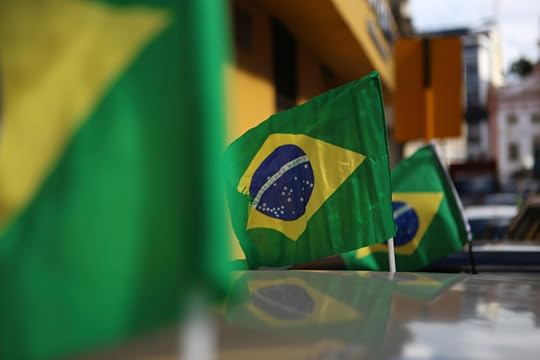
9
Cars everywhere show their support for the home team.

10
A local man protests against Brazil’s expenses for the World Cup.

11
A Brazilian fan shows support for Germany in front of Fonte Nova stadium in Salvador.

12
Football fans bearing flags for Portugal, Brazil, and Germany.

13
A fan in Pelourinho shows support for both Brazil and Croatia.

14
Happy fans celebrate a Brazilian goal at the FIFA Fan Fest in front of the Barra Lighthouse in Salvador.

15
German fans outside Fonte Nova stadium in Salvador.

16
Portugal fans head into Fonte Nova stadium in Salvador.

17
Fans of all ages dress in green, yellow and blue.

18
A local boy clutches a Brazil ball in Salvador’s historic center.

19
German fans get ready for the match outside Fonte Nova stadium in Salvador.
28 sporting events you need to see
I’VE ALWAYS WANTED to go to the World Cup, but it’s probably going to be a while. I couldn’t afford Brazil, and I don’t have much of a desire to go to Russia in 2018 or Qatar in 2022. So for the next 12 years at least, I’m going to have to start knocking off all of the other major “must-see” sporting events on my list.
There are different reasons to go, of course. You’ve got the sports that you actually care about, but then there are other events you want to go to more for the party that surrounds it, or for the spectacle of the game.
No one, for example, knows the point of a monster truck rally beyond “let’s crash cars and bring out Truckasaurus.” But it looks like so much fun to watch. So here’s my list of must-sees, with some mainstream events and a few lesser-known, quirkier options thrown in as well. 

1
The World Cup
The World Cup is obviously #1 on my list. No sport is as truly international as soccer, and there’s no other sport where my home team, the United States, is the underdog. It’s not quite as extensive as the Olympics, because only 32 teams can participate, but it remains one of the best international competitions out there.
(via)

2
The Summer Olympics
I made the gigantic mistake of leaving London two weeks before the Olympics started in 2012. I lived in the East End, so I expected it to be a nightmare, but everyone who stayed said it was perfectly managed and not at all a pain in the ass. And in terms of sports, there’s just so much to choose from during the Summer Olympics. This has to be my #2.
(via)

3
The Kentucky Derby
I’ve wanted to go to the Kentucky Derby ever since reading Hunter Thompson’s article “The Kentucky Derby is Decadent and Depraved.” By all accounts it’s a shitshow, and by all accounts the celebrity and funny hat sightings are unparalleled.
(via)
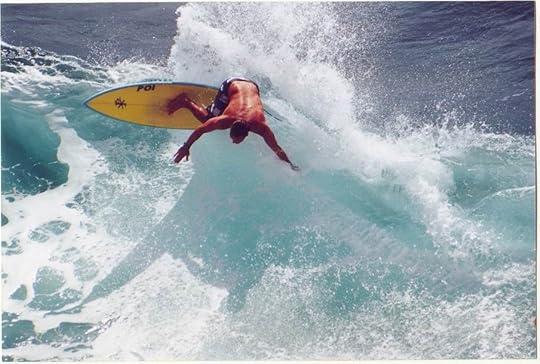
4
ISA World Masters Surfing Championship
Surfing is probably the most baller sport on the planet, and at the end of the day, you still get to watch it on the beach. Surfing, FTW.
(via)

5
Wimbledon
I’m not a big tennis guy, but Wimbledon sounds fun solely on the basis of being a gathering of Britain’s upper class, including the Royal Family. Also, I don’t even understand how you can play tennis on grass. I can barely manage it on turf.
(via)

6
Roller derby
One of the only contact sports that consists mostly of female players, the point of roller derby is to lap your opponents and to prevent them from lapping you. This can get violent. It’s awesome to watch, and a lot of fun to play.
(via)
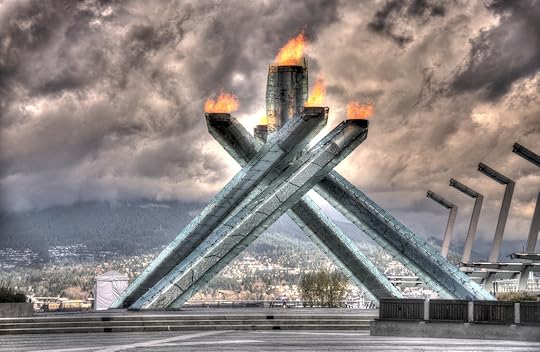
7
The Winter Olympics
I’m absolutely petrified of skiing—every tree seems to be intent on bashing my head in, and I’ve been known to fall over while standing perfectly still—so the Winter Olympic games always seem doubly impressive to me. I’ve even come around to figure skating. You can’t argue that the Winter Games don’t feature some of the most skilled athletes in any sport.
(via)
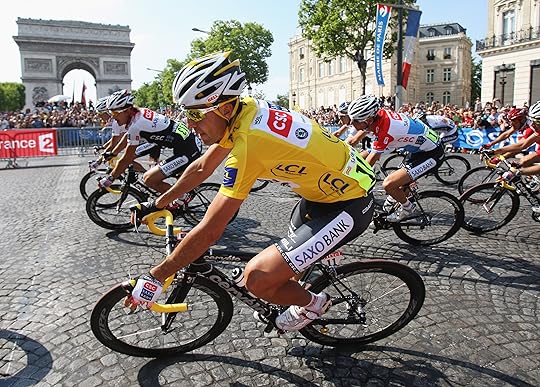
8
Tour de France
This is one of those events that, for the most part, consists of you standing in one place and watching the bicyclists zip by, but the perk is that you get to be pretty much everywhere in France during it. The Tour de France is an endurance sport, and even though cycling is plagued by doping scandals, it’s immensely impressive to watch.
(via)
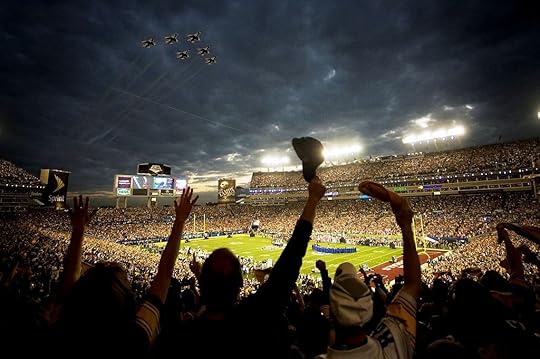
9
The Super Bowl
As an American, this is a must. But it’s only a must when your team goes, because the tickets are hella expensive. My team, the Cincinnati Bengals, haven’t been since I was three years old. So fingers crossed they make it back before I turn 30.
(via)
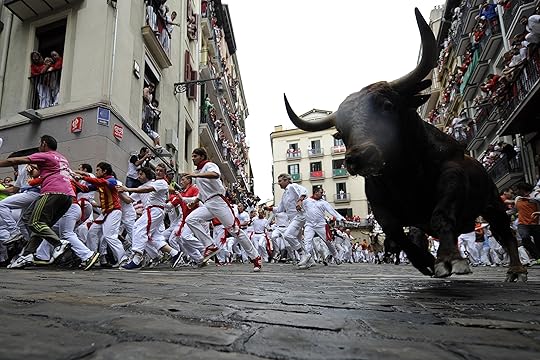
10
Running of the bulls
Okay, so it might be kinda suicidal to do actually run with the bulls, but by all accounts, the nights before and during the bullfights are absolutely crazy parties. And you can stand and watch the running of the bulls from the side of the road, totally safe.
(Via)

11
X Games
The X Games are organized by ESPN, and they feature extreme sports. So if you want to see incredibly skilled people doing incredibly dumb and dangerous things, check out the X Games. They’ve also made it a pretty great social event by putting on concerts during the run of the games.
(via)
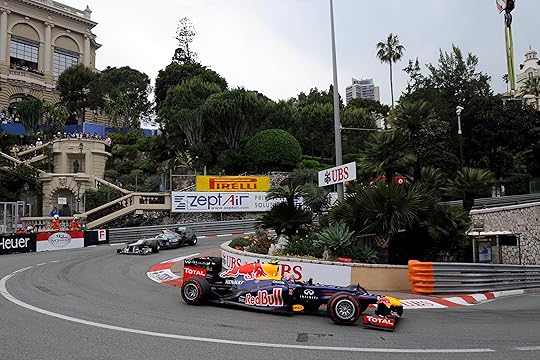
12
Grand Prix de Monaco
I want to go to the Grand Prix mostly as an excuse just to be in Monaco. But also, the race itself is supposed to be mesmerizing—that many F1 cars racing through narrow streets, through tunnels, and around hairpin turns? Yes, please.
(via)

13
Iditarod
This is an event you’ll have to put in hard work to follow—most of it happens out in the vast expanse of open Alaskan tundra. Dogsled racing is an endurance sport, and is a sport of patience, but you get to hang out in Alaska during the winter and eat comfort food while waiting for the racers to pass through town. Sold.
(via)

14
The Henley Regatta
This is another Royal-sponsored contest, and is one of the few items on this list that I’ve managed to tick off of my list. My cousin rowed for the University of Washington in the Henley Regatta while I was living in London. It’s like the British version of the Kentucky Derby, with incredibly posh, colorful outfits. But there’s surprisingly less drinking than at the Derby.
(via)

15
Stanley Cup
Hockey is one of the most fun games to watch live. A bunch of bruisers on skates literally pounding the teeth out of each other? How could that be bad? Though best spectated when your team is in the running, the Stanley Cup would be a fun event to attend no matter what.
(via)

16
Argentine Polo Championship
For whatever reason, the Argentines have clung to polo long after most countries have let it fall by the wayside as a relic of more aristocratic times. Still, the polo championships, held every year in Buenos Aires, are supposed to be an absolute blast. Though, to be fair, pretty much everything is fun in BA.
(via)

17
Champions League Final
The UEFA Champions League is the most prestigious club football (soccer) tournament in Europe, which means it’s also the most prestigious in the world. It’s like the Olympics, but instead of countries being represented, it’s teams. I’d love to see my favorite American football teams play European teams, but sadly we don’t have that reach. I watch this every year on TV, but one day I’ll make it to it live.
(via)

18
Indianapolis 500
I grew up an hour and a half from Indy, so it’s a shame I never made it to the Indy 500. It’s billed as one of the best races in the world, and it has a slightly different fan-base than NASCAR. So thank god for that.
(via)

19
Rugby World Cup
I’ve had rugby explained to me a few times, and I’ve never quite retained the rules because I always get caught up in the “Holy shit, look at those guys wail on each other.” Rugby’s a game that should’ve caught on in the United States, but was supplanted by American football. Oh well. This absolutely goes on the list.
(via)

20
World Series of Poker
Let’s be honest—you’re going to the WSOP to be in Vegas. Because for the most part, the WSOP is a slow tournament, happening over thousands of hands and a long period of time. That said, the stakes are incredibly high, and you get to watch players who are both wisecracking jackasses, and silent, stony-faced terrors. The personalities are as much fun as the game itself.
(via)
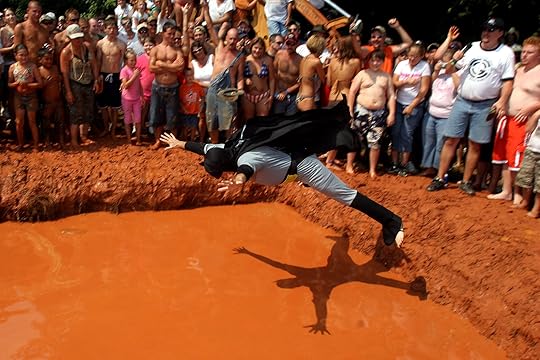
21
Summer Redneck Games
Held in East Dublin, Georgia, the Redneck Games feature events like Dumpster Diving, Mud Pit Belly Flopping, Bobbing for Pig’s Trotters, and Bug Zapping by Spitball. Oh, and a wet t-shirt contest, of course. If that doesn’t sell you on it…well, to be honest, I totally understand if that doesn’t sell you on it.
(via)

22
24 Hours of Le Mans
It’s like the Cannonball Run, but legitimate, and with real race cars. Endurance racing is pretty awesome across the board, and finishing it is as much an indication of driver skill as it is of mechanical engineering. Do you realize how much work has to go into a car to keep it going for that long? This would be a lot of fun to watch.
(via)

23
FA Cup Final
The oldest Football Association competition in the world will probably only interest those with an English team, but it’s another example in which the English have a leg up on American sports. Not only do they have a league winner, they also have a tournament winner. It may sound like a small distinction, but what if we had the equivalent of two Super Bowls? That shit would be sweet.
(via)
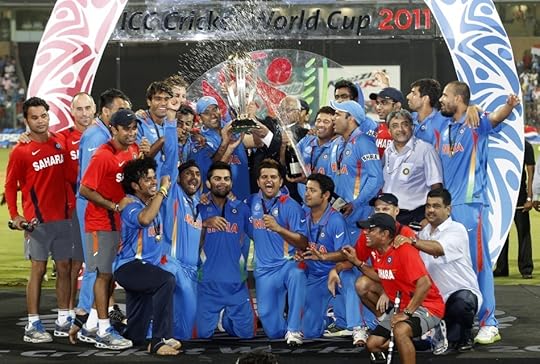
24
ICC Cricket World Cup
I can’t understand cricket for the life of me. There’s something called a wicket, I know, and also a bowler, but that’s about it. The appeal here is that I would love to go to a major sporting event and watch fans go absolutely apeshit over something that makes zero sense to me.
(via)

25
Chess boxing
Seriously, this is a thing. The rounds alternate between chess and boxing, and you can win by knocking out your opponent, putting them in checkmate, or through decision at the end of the match. It’s the perfect mix of brains and violence.
(via)

26
Scottish Highland Games
The games themselves are mostly men in kilts throwing really heavy things. But the Highland Games are at the same time a celebration of Scottish culture. And that means music, dance, and whisky as well.
(via)

27
Monster truck rally
Basically, you watch big cars smash other cars. That’s all there is to it.
(via)

28
World's Strongest Man competition
Comically large men lifting huge barbells and pulling trucks and tossing kegs. It’s probably the purest display of machismo you’ll ever see.
(via)
June 22, 2014
Karate all-star kicks ass
I WANT MY kids to learn karate. I never had the chance to do it myself (I was too scared to be flipped over on a mat by a sensei), but I hear it works wonders in teaching people the art of discipline, and self-defense. The Japanese got a lot right in terms of lifestyle choices (light and healthy diet, simplified zen living quarters, technological advancements, etc.) so it only makes sense that this karate student would literally kick ass in this video.
Most people think this video is staged; I tend to agree with them, but at the same time, it is still pretty cool to see someone smaller than myself beat the crap out of a grown man (I don’t speculate that the karate student is a child; the average height of a Japanese woman is 5’2″ so it very well could have been a teenager, or a very small adult).
The danger however, is in wondering whether or not this scenario is truly realistic. I’ve taken self defense classes before, but the techniques did not keep me from losing to an attacker on a train ride home from New York City. Maybe with years of practice I could have defended myself better, but it does make me wonder — if this attacker had put up more of a fight, would his victim have succeeded in the same way? 
June 21, 2014
Kiteboarding Aruba on land and sea
SO SKATEBOARDING’S COOL, and so is surfing, but you know what it just doesn’t have enough of? Hang time. Kiteboarding’s the sport that fixes that, and a group of kiteboarders in Aruba put together this video of how you can do all kinds of awesome shit strapped to a kite.
It looks incredible, but I feel like I’d want to see a wipeout reel before I give it a try myself. 
6 tips for driving in São Paulo
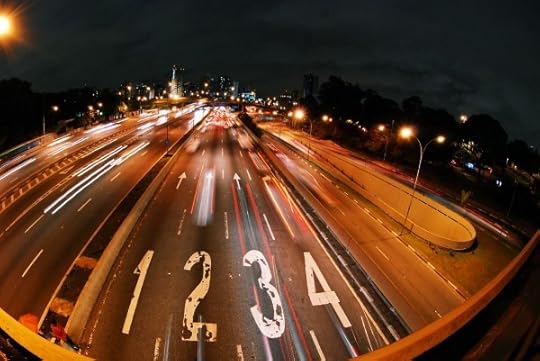
Photo: Gustavo Gomes
1. Don’t drive.
Think about returning that rental car and hailing a cab. Unless you happen to be a native Brazilian, your biology’s probably all wrong.
The Brazilians I know have a gift called jeito or “way,” usually meaning “a way around the rules.” They zigzag, tailgate, swerve, and samba around town without even nicking their side-view mirrors. They don’t fret about things like speed limits and stop signs because they know just how far they can push without getting into real trouble.
2. Remember that three rights make a left.
I discovered this rule the first time I tried driving to the local grocery store. The concierge in my extended-stay hotel gave me a map, pointed a pen toward an intersection two blocks away, and marked it with a thick “X.” I got in the car, drove for a minute, and saw the grocery store coming up on the left-hand side, just as expected. I flicked the blinker smugly. And kept looking. It took me a few seconds to realize there was no place to turn from the left lane in which I was driving.
I could’ve walked through the checkout line an hour earlier if I’d known this rule in advance: Left turns are almost always impossible in São Paulo. You can only make them on tiny, obscure streets, or on a one-way street to another one-way street. Do what the cab drivers do, and make three right turns instead.
3. Honor the motoboys.
Motoboys are São Paulo’s motorbike riders. They deliver things that need to get somewhere quickly, like documents, packages, or meals. Other drivers wait 45 minutes for a light to turn green, but these boys don’t seem to play by the same rules.
One time, a motoboy nearly buzzed into the side of my car and then cut in front, even though we were the only two people on the road. I responded with my worst glare, but he did something unexpected in return. He looked back at me and smiled, ran his fingers down his face and pretended to cry, all the while roaring ahead at 60mph.
Try to be extra cautious around the motoboys. If you make the lead motoboy of a pack angry by cutting him off, his buddies will try to rip your side mirror off. They’re trying to protect themselves in a city where at least one motoboy dies a day. So before you switch lanes, look — and then look again to make sure the motoboys are out of the way.
4. Remember that nunca means “never.”
There’s one rule in São Paulo that even Paulistanos with the most jeito hold sacred: NUNCA FECHE O CRUZAMENTO. Never block the intersection, not even if you’re fairly sure the bottleneck in the middle of the road will clear up before the yellow light turns red.
You’ll see signs with this rule at a lot of intersections, especially downtown. It’s a way of keeping traffic from totally paralyzing the city. A professional driver named Leonardo Araújo put it this way: “Here we have a name for people who block the intersection once the light turns red: fair game.”
5. Beware of ‘bad guys.’
Vendors of all ages will bombard you at all times of the day. They’ll tempt you with bonbons at your side-view mirror, flowers on your windshield, or, if you’re lucky, fire juggling. Give money away only when it’s light out, and only if other drivers manage to do the same without a problem.
6. Bring along snacks, and make sure your gas tank is full.
If you’re heading to a place as popular as a soccer game, bring along a bite to eat as you stare at the back of a stopped car for long stretches of time.
My husband and I once drove to the Guarulhos airport at the beginning of a holiday weekend. The entire city was on its way to the same airport, and we waited for some lights to turn green seven times before we were able to sneak through the intersection. Even the ambulances couldn’t make any progress. We reached the airport four hours later and were told it was too late to board the flight. 
June 20, 2014
Travel tips your dog can teach you

Image: /Toni Blay
1. Say “Hi, Hey, How you doing, Damn, Why you smell so good, Ummmmm I’m gonna lick your face,” to almost everyone you meet.
Say hello to strangers. Be interested and interesting. Invite a new friend to share that bottle of wine in your hostel fridge, because…
2. Every person is awesome.
Every place is original. Every moment is fantastic.
3. Try the local cuisine wherever you go.
Eat absolutely everything you find: fish, bread, insects, rice salad, hákarl, napkins with tasty flavors, spicy chicken, goat cheese, enchiladas, sashimi, jamón ibérico, filet mignon, sardines, steak, steak, steak…
4. Clean yourself.
And remember that your butt isn’t everything. You have more body to wash.
5. Clothes are not as necessary as you think.
Let the air touch your skin. Be fresh, my friend!
6. Be brave.
Don’t be afraid of bigger, stronger, or smarter dogs. And if you have to be, bark first and more.
7. Be a master of the “I’m-such-a-sweetie face.”
Practice it in front of a mirror. If you trick yourself into thinking, even for just a moment, that you’re a good dog and deserve a biscuit, you’ll be all right in your travels. You’ll need that face.
8. Use an effective flea collar.
You girls, above all. One every 20 pubs. Never go out without it.
9. Pee on every lamppost.
Since you’re so far from home, and you have no friends to cling to, live the adventure to the fullest. Fulfill your ambitions, overlook the past, and pee everywhere. Let people know how awesome you are.
10. You’re never too old.
There are 15-year-old dogs in every park. Maybe they’re crippled or deaf or blind, but so what? They still want to party with the puppies. And they still want to make wild dog-love to the sexy Dalmatians. Forget about your age. It’s never too late to explore the other side of the world.
11. Fight for your possessions.
When you’re living in a hostel room with seven strangers, your favorite socks are untouchable. Defend them against potential marauders with teeth and claws.
12. Cheer up the people around you.
C’mon, if you really consider yourself a good globetrotter, you don’t need to be cute like your dog to make people happier. You’re exotic and probably bilingual and you know jokes from all over the world.
13. Follow your canine instincts.
And just do things. Get up every morning with no plan and improvise, because life is just a sabbatical jungle full of cats and dogs and birds. Dogs run and bark and follow trails. Dogs don’t worry about art galleries closing, or about how many things they have to do before the semester ends.
14. Smell different butts and never stop looking for better bones.
You have a good nose and perfect fangs. You’re fit and your tongue is longer than you think. So no worries for settling down too late. You never know what butt is waiting for you in the next urinated corner. There are brighter bones everywhere, for real. 
Matador Network's Blog
- Matador Network's profile
- 6 followers




